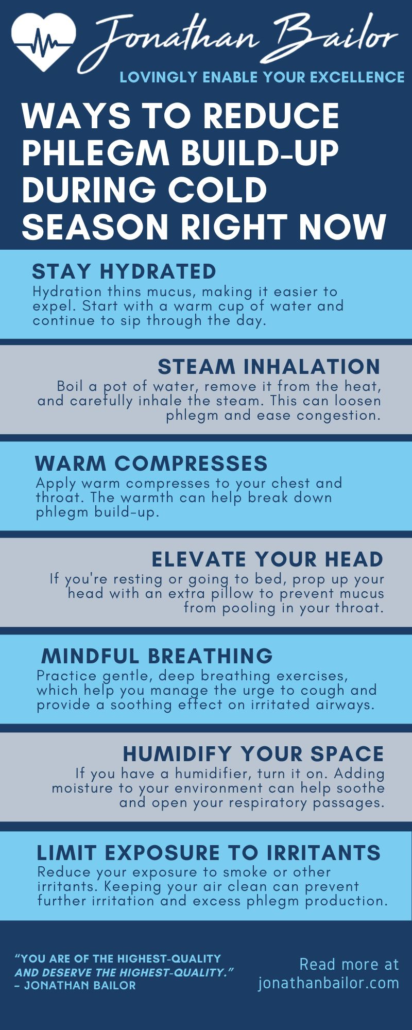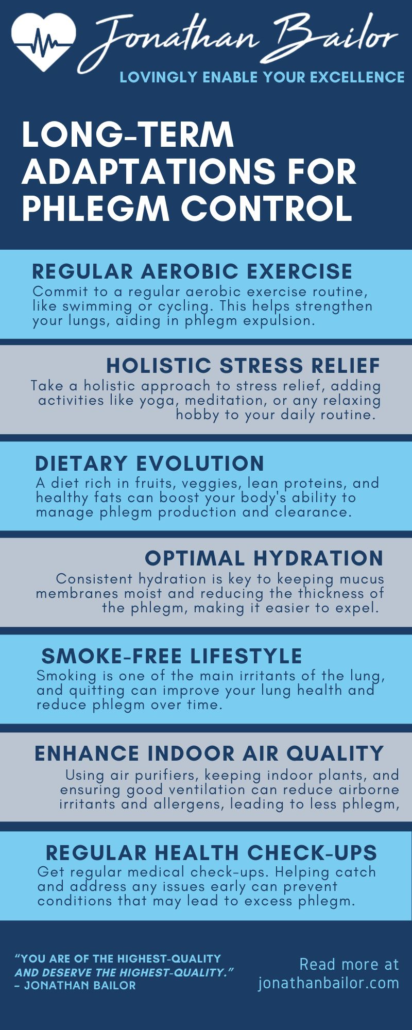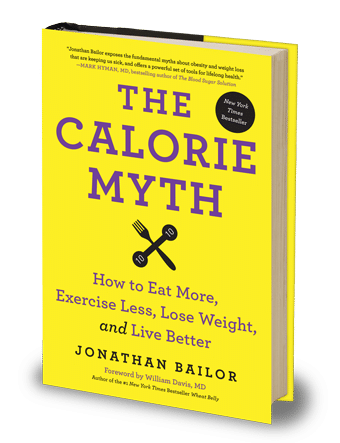28 Habits for Minimizing Phlegm Build-Up During Cold Season Now and Later
Here are 28 habits for minimizing phlegm build up during cold season now AND later! As the cold season wraps its chilly arms around us, many find themselves battling the unwelcome guest of excess mucus and phlegm build-up. It’s a familiar tale, yet one that need not define our winter narrative. This cough and phlegm guide, Jonathan Bailor will discuss charting a course through every stage of life with habits that help keep phlegm at bay, ensuring that your days are as clear and comfortable as a crisp winter morning.
Need more ways to battle cold season? Surf over to our Harnessing Breath: 27 Techniques to Calm Coughing Fits and 26 Tips for Managing Chronic Coughs Without Medication guides next!
We’re diving into a variety of habits, each a stepping stone to better respiratory health, no matter your age or stage in life. These aren’t just temporary fixes; they’re lifelong practices that offer a buffer against the seasonal surge of phlegm. From simple adjustments in your daily routine to embracing practices that support overall respiratory health, each habit is a thread in the tapestry of lifelong wellness.
Imagine the relief and empowerment that come with mastering these habits and the joy of sharing them with those around you. Picture a conversation with a friend or a family member, where you pass on these nuggets of wisdom, spreading not just knowledge but also the promise of healthier, phlegm-free winters.
So, let’s embark on this journey together, embracing habits that serve us at every turn of life’s path, clearing the way for a season of comfort, health, and joyful breathing.
Instant Steps: Immediate Actions to Curb Phlegm Build-Up
When phlegm starts to cloud your days, there are immediate steps you can take to clear the air. Here are some actions you can implement right now to combat phlegm build-up:
1. Stay Hydrated
Begin by increasing your water intake. Hydration thins mucus, making it easier to expel. Start with a warm cup of water and continue to sip throughout the day for immediate relief.
2. Steam Inhalation
Boil a pot of water, remove it from the heat, and carefully inhale the steam. This can provide instant moisture to your airways, loosening phlegm and easing congestion.
3. Warm Compresses
Apply warm compresses to your chest and throat. The warmth can help break down mucus, offering quick relief from the heaviness of phlegm build-up.
4. Elevate Your Head
If you’re resting or going to bed, prop up your head with an extra pillow. This position can prevent mucus from pooling in your throat, reducing cough and easing breathing.
5. Mindful Breathing
Practice gentle, deep breathing exercises. This can help you manage the urge to cough and provide a soothing effect on irritated airways, offering immediate comfort.
6. Humidify Your Space
If you have a humidifier, turn it on. Adding moisture to your environment can help soothe and open your respiratory passages, providing quick relief from phlegm discomfort. (If you have young children, you may want to use a cool mist humidifier for safety reasons.)
7. Limit Exposure to Irritants
Immediately reduce your exposure to smoke, strong perfumes, or other irritants. Keeping your air clean can prevent further irritation and excess phlegm production.
These immediate steps are like first aid for phlegm build-up, offering quick relief and a path to clearer, more comfortable breathing in the here and now.

Feeling Better Is Priceless, That's Why We Don't Put A Price On It!
“It’s Like A Free and Medically Valid Version of Noom and Weight Watchers Online”
~ Dr. Doctor Matthew Oleshiak, MD
Click the 'LEARN MORE' button below for free lifetime access to the fast fix program developed by Jonathan and top Ivy League Medical Doctors
LEARN MOREP.S. It's not a free trial. It's not part of the program for free. The entire program is free, forever, for real! No credit card needed.
Short-Term Strategies: Day-to-Day Adjustments to Alleviate Phlegm
As you navigate through the cold season, certain short-term changes, implementable over a few days, can significantly impact phlegm management. Here are some practical adjustments to consider for quick yet lasting relief:
1. Adjust Your Diet
Over the next few days, focus on incorporating warm, soothing foods and beverages. Soups, broths, and herbal teas can comfort an irritated throat and help loosen phlegm. Avoid cold and overly processed foods, as well as spicy foods, as they may exacerbate mucus production.
2. Enhance Air Quality
Spend the next few days in environments with clean, fresh air. If you’re indoors, ensure good ventilation. Avoid areas with dust, smoke, or strong odors that can irritate your respiratory system and increase phlegm.
3. Gargle with Salt Water
Start a routine of gargling with warm salt water twice a day. This simple practice can help soothe your throat, reduce mucus, and combat bacteria that may be contributing to phlegm build-up.
4. Limit Dairy Consumption
Try reducing or eliminating dairy from your diet for the next several days. Some people find that dairy products can increase mucus production, so monitoring your response to this change can be revealing.
5. Introduce Gentle Exercise
Incorporate mild physical activities like slow-paced walking or stretching. Gentle movement can help boost circulation and lung function, aiding in the clearance of phlegm.
6. Manage Indoor Temperature
Over the coming days, keep your living space comfortably warm but not overly heated. Excessively dry air from heating can worsen phlegm, so maintaining a balanced room temperature is key.
7. Practice Relaxation Techniques
Engage in stress-reduction activities such as reading, meditating, or listening to calming music. Stress can impact your respiratory system, so finding ways to relax can help alleviate symptoms associated with phlegm.
These short-term changes are about making small yet effective, tweaks in your daily life, setting the stage for clearer breathing and reduced phlegm in the days ahead.

Week-by-Week Wellness: Medium-Term Tactics to Combat Phlegm
As you journey through the cold season, embracing changes over a few weeks can be instrumental in managing phlegm. Here are some medium-term strategies to incorporate into your routine, offering a sustained path to respiratory comfort:
1. Develop a Regular Sleep Pattern
Over the next few weeks, focus on establishing a regular sleep schedule. Consistent, quality sleep is vital for immune function and can help your body more effectively manage phlegm production and clearance.
2. Introduce a Moderate Exercise Regimen
Gradually increase your physical activity with moderate exercises like brisk walking or light jogging. Regular exercise over a few weeks can enhance lung capacity and aid in the natural expulsion of phlegm.
3. Air Purification
Investing in an air purifier for your home could be wise, particularly if you reside in an area with poor air quality. Consistent use over the weeks can significantly reduce airborne irritants, aiding in phlegm reduction.
4. Mindful Breathing Practices
Start practicing mindful breathing techniques daily. Over the course of several weeks, these practices can strengthen your respiratory system, making it more efficient at managing phlegm.
5. Incremental Dietary Adjustments
Gradually shift your diet to include more anti-inflammatory foods like leafy greens, berries, and nuts. These dietary changes, sustained over weeks, can help reduce inflammation in the respiratory tract, reduce the risk of respiratory infections, and alleviate phlegm.
6. Stay Hydrated with Herbal Infusions
Make a habit of drinking herbal infusions rich in anti-inflammatory and soothing properties, like thyme or licorice root tea. Regular consumption over several weeks can provide ongoing relief from phlegm discomfort.
7. Regular Steam Inhalation
Incorporate steam inhalation into your weekly routine. Doing this regularly can maintain moisture in your respiratory passages, helping to reduce and loosen mucus and phlegm production, making it more manageable.
These medium-term adjustments are about weaving habits into the fabric of your weekly routine, each contributing to a gradual yet noticeable improvement in managing phlegm, leading to clearer, more comfortable days and nights.

Sustained Harmony: Long-Term Adaptations for Phlegm Control
Embarking on long-term changes can profoundly impact your ability to manage phlegm build-up, especially during the cold season. Here are several long-term strategies to integrate into your life, setting a foundation for lasting respiratory health:
1. Regular Aerobic Exercise
Commit to a consistent aerobic exercise routine, like swimming or cycling. Over months, this helps strengthen your lungs and respiratory system, making them more efficient at handling phlegm and reducing susceptibility to respiratory issues.
2. Holistic Stress Management
Develop and maintain a holistic approach to stress management, incorporating activities like yoga, meditation, or any hobby that brings you joy and relaxation. Chronic stress can affect your immune system and respiratory health, so managing it effectively can have a significant long-term impact on reducing phlegm.
3. Dietary Evolution
Gradually evolve your diet to emphasize anti-inflammatory and immune-boosting foods. Over the long term, a diet rich in fruits, vegetables, lean proteins, and healthy fats can improve your overall health and your body’s ability to manage phlegm.
4. Maintain Optimal Hydration
Make a long-term commitment to staying well-hydrated. Consistent hydration is key to keeping mucus membranes moist and reducing the thickness of the phlegm, making it easier for your body to manage.
5. Pursue a Smoke-Free Lifestyle
If you smoke, consider quitting as a long-term goal. Smoking is one of the primary irritants of the respiratory system, and quitting can dramatically improve your lung health and reduce phlegm over time.
6. Enhance Indoor Air Quality
Invest in improving the air quality of your home. Over the long term, using air purifiers, keeping indoor plants, and ensuring good ventilation can significantly reduce airborne irritants and allergens, contributing to less phlegm production.
7. Regular Health Check-Ups
Make a habit of regular medical check-ups. Long-term monitoring of your respiratory health can help catch and address any issues early, preventing conditions that may lead to increased phlegm production.
These long-term changes are about crafting a lifestyle that naturally supports your respiratory system, offering a sustainable path to managing phlegm and enjoying clearer, healthier days throughout the year.

Soothing Answers: Coughing & Phlegm FAQ
When it comes to understanding coughing and phlegm, questions abound. Let’s delve into some common inquiries to bring clarity and comfort:
Q1: Why does a cough often worsen at night?
Coughing can intensify at night due to lying down. This position allows mucus to pool in the throat, which can trigger the cough reflex. Dry indoor air and allergens in bedding can also contribute to this increase in coughing intensity.
Q2: Can certain foods exacerbate cough and phlegm?
Yes, some foods might worsen cough and phlegm for certain individuals. Dairy products, for instance, can sometimes thicken mucus, making coughing more prevalent. Spicy or acidic foods might also irritate the throat, leading to more coughing. Observing how different foods affect your symptoms is key to managing them.
Q3: What is the significance of phlegm color changes?
The color of the phlegm can indicate different conditions. Clear phlegm is usually normal; yellow or green may suggest a sinus infection, viral infection, or seasonal allergies; brown or red, which could indicate blood, might signal a more serious condition. If you notice phlegm and mucus production of a significantly different color than usual, especially if accompanied by other symptoms, it’s wise to consult a healthcare professional.
Q4: Is steam inhalation effective for cough and phlegm?
Yes, steam inhalation can be quite effective. It helps moisturize the airways, loosens phlegm, and can soothe the mucous membranes of the throat and lungs, reducing the urge to cough.
Q5: How can I naturally reduce phlegm and ease coughing?
Staying hydrated is key as it helps thin out mucus, making it easier to expel. Warm beverages like herbal teas can soothe the throat. Avoiding irritants like smoke and using a humidifier can also reduce coughing and phlegm production.
Understanding these aspects of coughing and phlegm is essential for effective management and comfort, enabling you to navigate these symptoms with greater ease and confidence.
Breathing Easy: Sharing the Journey to Cough and Phlegm Relief
As we close this chapter on understanding and managing coughing and phlegm, let’s not let the conversation end here. If these insights have shed light on your experiences, think of the comfort they could bring to others in your circle.
Spread the knowledge and relief by sharing this guide with friends and family through social media, email, or heartfelt conversations. In doing so, you’re not just passing on information; you’re extending a hand of care and support. Together, let’s create a community where breathing easy is a shared journey, one where every voice and every breath counts.
Feeling Better Is Priceless, That's Why We Don't Put A Price On It!
“It’s Like A Free and Medically Valid Version of Noom and Weight Watchers Online”
~ Dr. Doctor Matthew Oleshiak, MD
Click the 'LEARN MORE' button below for free lifetime access to the fast fix program developed by Jonathan and top Ivy League Medical Doctors
LEARN MOREP.S. It's not a free trial. It's not part of the program for free. The entire program is free, forever, for real! No credit card needed.




